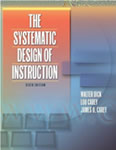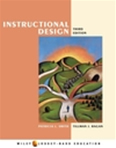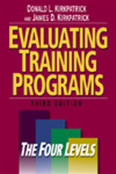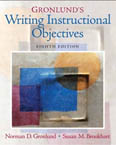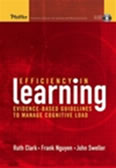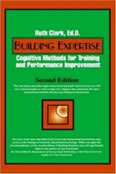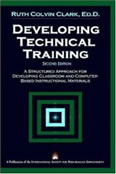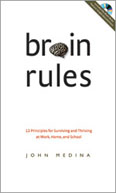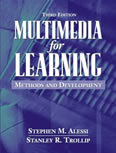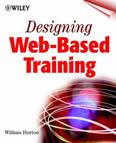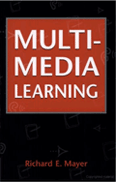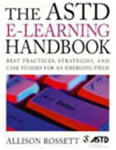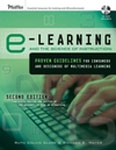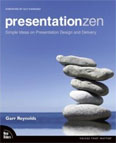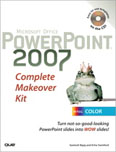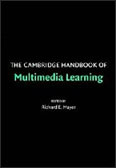 |
Mayer, Richard (ed). (2005). The Cambridge handbook of multimedia learning. New York: Cambridge University Press.
This is the single best collection of articles from today's leading researchers in multimedia learning available. The book provides an excellent sampling of research associated with how people learn through the combination of words (text and/or audio) and images (still illustrations or photos, animations, and/or video) available. Anyone working in multimedia learning will benefit from gaining a firm understanding of the principles presented throughout this book.
Mayer provides the following definitions to ground the readings:
| Term |
Definition |
| Multimedia |
Presenting words (such as printed text or spoken text) and pictures (such as illustrations,
photos, illustrations, photos, animation, or video) |
| Multimedia Learning |
Building mental representations from words and pictures |
| Multimedia Instruction |
Presenting words and pictures that are intended to promote learning |
The book is divided into five parts:
| Section |
Contents |
| Theoretical Foundations |
Foundational learning theories, including cognitive load and how multi-modal message delivery
(text/audio and graphics) support learning |
| Basic Principles of Multimedia Learning |
Research supporting key principles in the development of multimedia instruction and achieving
multimedia learning, including split-attention principle, modality principle, redundancy, segmentation, coherence,
signaling, spatial & temporal contiguity, and personalization. |
| Advanced Principles of Multimedia Learning |
Research on the incorporation of multimedia products into a learning approach, including guided
discovery, worked-out examples, collaboration, self-explanation, navigation, and prior knowledge. |
| Multimedia in Content Areas |
Articles containing guidance for developing multimedia learning environments in various content
areas, including reading, history, mathematics, chemistry, meteorology, physical systems, second language acquisition,
and cognitive skills. |
| Multimedia Learning in Advanced Computer-Based Contexts |
Focuses on multimedia in emerging technologies, including pedagogical agents; virtual reality;
games, simulations, & microworlds; hypermedia; and e-courses. |
Here are abstracts from some of the articles:
Implications of Cognitive Load Theory for Multimedia Learning – John Sweller
Working memory is limited and has no logical “central executive” available to organize new
information. When building onto existing schema, instruction should relate to the existing schema. When
presenting new concepts, instruction should be organized to support the development of a new successful schema.
Cognitive Theory of Multimedia Learning – Richard E. Mayer
A fundamental hypothesis underlying research on multimedia learning is that multimedia instructional messages
that are designed in light of how the human mind works are more likely to lead to meaningful learning than
those that are not. The cognitive theory of multimedia learning (CTML) is based on three cognitive science
principles of learning: the human information processing system includes dual channels for visual/pictorial and
auditory/verbal processing (i.e., dual-channel assumption); each channel has limited capacity for processing
(i.e., limited capacity assumption); and active learning entails carrying out a coordinated set of cognitive
processes during learning (i.e., active processing assumption).
The cognitive theory of multimedia learning specifies five cognitive processes in multimedia learning:
- Selecting relevant words from the presented text or narration,
- Selecting relevant images from the presented illustrations,
- Organizing the selected words into a coherent verbal representation,
- Organizing selected images into a coherent pictorial representation, and
- Integrating the pictorial and verbal representations and prior knowledge.
Multimedia instructional messages should be designed to prime these processes.
The Four-Component Instructional Design Model: Multimedia Principles in Environments for Complex
Learning – Jeroen J. G. van Merrienboer & Liesbeth Kester
The Four-Component Instructional Design (4C-ID) model claims that four components are necessary to realize
complex learning:
- Learning tasks
- Supportive information
- Procedural information
- Part-task practice
Students may work on learning tasks in simulated task environments, where relevant multimedia principles
primarily facilitate a process of inductive learning. They may study supportive information in
hypermedia systems, where principles facilitate a process of elaboration and mindful abstraction.
They may consult procedural information in Electronic Performance Support Systems (EPSSs), where principles
facilitate a process of knowledge compilation. Finally, they may be involved in part-task practice with
drill and practice Computer-Based Training (CBT) programs, where principles facilitate a process of
psychological strengthening.
The Multimedia Principle – J.D. Fletcher & Sigmund Tobias
The multimedia principle states that people learn better from words and pictures than from words alone.
Effectiveness of combining imagery with text varies with the content to be learned, the conditions under
which performance is measured, and individual differences in spatial ability, prior knowledge, and general
learning ability.
The Split-Attention Principle in Multimedia Learning – Paul Ayres & John Sweller
The split-attention principle states that when designing instruction, including multimedia instruction,
it is important to avoid formats that require learners to split their attention between, and mentally
integrate, multiple sources of information. Instead, materials should be formatted so that disparate
sources of information are physically and temporally integrated thus obviating the need for learners to engage
in mental integration. By eliminating the need to mentally integrate multiple sources of information,
extraneous working memory load is reduced, freeing resources for learning.
The Modality Principle in Multimedia Learning – Renae Low & John Sweller
The capacity limitations of working memory are a major impediment when students are required to learn new
material. Furthermore, those limitations are relatively inflexible. However, presenting some
information in visual mode and other information in auditory mode can expand effective working memory
capacity, reducing the effects of excessive cognitive load.
The Redundancy Principle in Multimedia Learning – John Sweller
The redundancy principle suggests that redundant information interferes with rather than facilitates learning.
Redundancy occurs when the same information is presented in multiple forms or is unnecessarily elaborated.
Instructional designs that eliminate redundant material can be superior to those that include redundancy.
Principles for Managing Essential Processing in Multimedia Learning: Segmenting, Pretraining, and Modality
Principles – Richard Mayer
When a concise narrated animation containing complicated material is presented at a fast rate, the result
can be a form of cognitive overload called essential overload. Essential overload occurs when the
amount of essential cognitive processing (similar to intrinsic cognitive load) required to understand the
multimedia instructional message exceeds the learner’s cognitive capacity.
Three multimedia design methods intended to minimize essential overload are the segmenting, pretraining, and
modality principles:
- Segmenting principle: People learn more deeply when a multimedia message is presented in
learner-paced segments rather than as a continuous unit.
- Pretraining principle: People learn more deeply from a multimedia message when they know the
names and characteristics of the main concepts.
- Modality principle: People learn more deeply from a multimedia message when words are spoken
rather than printed.
Principles for Reducing Extraneous Processing in Multimedia Learning: Coherence, Signaling, Redundancy,
Spatial Contiguity, and Temporal Contiguity Principles – Richard Mayer
Extraneous overload occurs when essential cognitive processing (required to understand the essential
material in a multimedia message) and extraneous cognitive processing (required to process extraneous
material or to overcome confusing layout in a multimedia message) exceeds the learner’s
cognitive capacity.
Five multimedia design methods intended to minimize extraneous overload are the:
- Coherence principle: People learn more deeply from a multimedia message when
extraneous material is excluded.
- Signaling principle: People learn more deeply from a multimedia message when cues are
added that highlight the organization of the essential material.
- Redundancy principle: People learn more deeply from graphics and narration than
from graphics, narration, and onscreen text.
- Spatial contiguity principle: People learn more deeply from a multimedia message
when corresponding words and pictures are presented near rather than far from each other on the screen/page.
- Temporal contiguity principle: People learn more deeply from a multimedia message when
corresponding animation and narration are presented simultaneously rather than successively.
Principles of Multimedia Learning Based on Social Cues: Personalization, Voice, and Image Principles – Richard
Mayer
Social cues may prime social responses in learners that lead to deeper cognitive processing during learning
and hence better test performance. The personalization principle is that people learn more deeply when
the words in a multimedia presentation are in conversational style rather than formal style. The
voice principle is that people learn more deeply when the words in a multimedia message are spoken in a
standard-accented human voice rather than in a machine voice or foreign-accented human voice. The
image principle is that people do not necessarily learn more deeply from a multimedia presentation when the
speaker’s image is on the screen rather than not on the screen.
The Guided Discovery Principle in Multimedia Learning – Ton de Jong
Inquiry or scientific discovery learning environments are environments in which a domain is not directly
offered to learners but in which learners have to induce the domain from experiences or examples.
Because this is a difficult task he discovery process needs to be combined with guidance (e.g.,
scaffolding, cognitive tools) for the learner. The most effective way to provide this guidance is
to integrate it in the learning environment. Guidance may be directed at one or more of the discovery
learning processes. With adequate guidance discovery learning can be an effective learning approach
in which mainly “intuitive” or “deep” conceptual knowledge can be acquired.
The Collaboration Principle in Multimedia Learning – David Jonassen, Chwee Beng Lee, Chia-Chi Yang,
& James Laffey
Based on sociocultural and social cognitive theory, computer support for collaborative learning has emerged
as a new research and development subdiscipline of computer-mediated communication.
The Self-Explanation Principle in Multimedia Learning – Marguerite Roy & Michelene Chi
Learning in multimedia environments is hard because it requires learners to actively comprehend and
integrate information across diverse sources and modalities. Self-explanation is an effective
learning strategy that helps learners develop deep understanding of complex phenomena and could be used
to support learning from multimedia.
|

